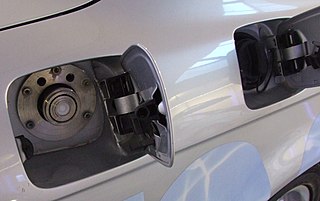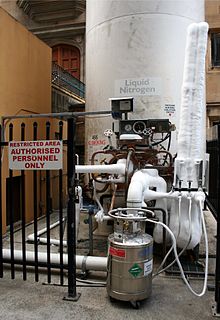Related Research Articles

In physics, cryogenics is the production and behaviour of materials at very low temperatures.

Liquid hydrogen (LH2 or LH2) is the liquid state of the element hydrogen. Hydrogen is found naturally in the molecular H2 form.
A propellant is a mass that is expelled or expanded in such a way as to create a thrust or other motive force in accordance with Newton's third law of motion, and "propel" a vehicle, projectile, or fluid payload. In vehicles, the engine that expels the propellant is called a reaction engine. Although technically a propellant is the reaction mass used to create thrust, the term "propellant" is often used to describe a substance which is contains both the reaction mass and the fuel that holds the energy used to accelerate the reaction mass. For example, the term "propellant" is often used in chemical rocket design to describe a combined fuel/propellant, although the propellants should not be confused with the fuel that is used by an engine to produce the energy that expels the propellant. Even though the byproducts of substances used as fuel are also often used as a reaction mass to create the thrust, such as with a chemical rocket engine, propellant and fuel are two distinct concepts.

Liquid nitrogen—LN2— is nitrogen in a liquid state at low temperature. Liquid nitrogen has a boiling point of about −195.8 °C (−320 °F; 77 K). It is produced industrially by fractional distillation of liquid air. It is a colorless, low viscosity liquid that is widely used as a coolant.

Liquefied petroleum gas is a fuel gas which contains a flammable mixture of hydrocarbon gases, specifically propane and butane.

A boiling liquid expanding vapor explosion is an explosion caused by the rupture of a vessel containing a pressurized liquid that has reached temperature above its boiling point. Because the boiling point of a liquid rises with pressure, the contents of the pressurized vessel can remain liquid as long as the vessel is intact. If the vessel's integrity is compromised, the loss of pressure and dropping boiling point can cause the liquid to rapidly convert to a gas and expand rapidly. If the gas is combustible, as is the case with hydrocarbons and alcohols, further damage can be caused by an ensuing fire.
A refrigerator designed to reach cryogenic temperatures is often called a cryocooler. The term is most often used for smaller systems, typically table-top size, with input powers less than about 20 kW. Some can have input powers as low as 2–3 W. Large systems, such as those used for cooling the superconducting magnets in particle accelerators are more often called cryogenic refrigerators. Their input powers can be as high as 1 MW. In most cases cryocoolers use a cryogenic fluid as the working substance and employ moving parts to cycle the fluid around a thermodynamic cycle. The fluid is typically compressed at room temperature, precooled in a heat exchanger, then expanded at some low temperature. The returning low-pressure fluid passes through the heat exchanger to precool the high-pressure fluid before entering the compressor intake. The cycle is then repeated.
Cryogenic fuels are fuels that require storage at extremely low temperatures in order to maintain them in a liquid state. These fuels are used in machinery that operates in space where ordinary fuel cannot be used, due to the very low temperatures often encountered in space, and the absence of an environment that supports combustion. Cryogenic fuels most often constitute liquefied gases such as liquid hydrogen.

Bottled gas is a term used for substances which are gaseous at standard temperature and pressure (STP) and have been compressed and stored in carbon steel, stainless steel, aluminum, or composite bottles known as gas cylinders.
Liquid air is air that has been cooled to very low temperatures, so that it has condensed into a pale blue mobile liquid. To thermally insulate it from room temperature, it is stored in specialized containers. Liquid air can absorb heat rapidly and revert to its gaseous state. It is often used for condensing other substances into liquid and/or solidifying them, and as an industrial source of nitrogen, oxygen, argon, and other inert gases through a process called air separation.

Liquefaction of gases is physical conversion of a gas into a liquid state (condensation). The liquefaction of gases is a complicated process that uses various compressions and expansions to achieve high pressures and very low temperatures, using, for example, turboexpanders.

Industrial gases are the gaseous materials that are manufactured for use in industry. The principal gases provided are nitrogen, oxygen, carbon dioxide, argon, hydrogen, helium and acetylene, although many other gases and mixtures are also available in gas cylinders. The industry producing these gases is also known as industrial gas, which is seen as also encompassing the supply of equipment and technology to produce and use the gases. Their production is a part of the wider chemical Industry.

A bivalent engine is an engine that can use two different types of fuel. Examples are petroleum/CNG and petroleum/LPG engines, which are widely available in the European passenger vehicle aftermarket.

A liquid is a nearly incompressible fluid that conforms to the shape of its container but retains a (nearly) constant volume independent of pressure. As such, it is one of the four fundamental states of matter, and is the only state with a definite volume but no fixed shape. A liquid is made up of tiny vibrating particles of matter, such as atoms, held together by intermolecular bonds. Like a gas, a liquid is able to flow and take the shape of a container. Most liquids resist compression, although others can be compressed. Unlike a gas, a liquid does not disperse to fill every space of a container, and maintains a fairly constant density. A distinctive property of the liquid state is surface tension, leading to wetting phenomena. Water is by far the most common liquid on Earth.
The Glossary of fuel cell terms lists the definitions of many terms used within the fuel cell industry. The terms in this fuel cell glossary may be used by fuel cell industry associations, in education material and fuel cell codes and standards to name but a few.
A liquid nitrogen vehicle is powered by liquid nitrogen, which is stored in a tank. Traditional nitrogen engine designs work by heating the liquid nitrogen in a heat exchanger, extracting heat from the ambient air and using the resulting pressurized gas to operate a piston or rotary motor. Vehicles propelled by liquid nitrogen have been demonstrated, but are not used commercially. One such vehicle, Liquid Air, was demonstrated in 1902.
An air separation plant separates atmospheric air into its primary components, typically nitrogen and oxygen, and sometimes also argon and other rare inert gases.
Nitrogen, as an element of great technical importance, can be produced in a cryogenic nitrogen plant with a purity of more than 99.9999%. Air inside a distillation column is separated at cryogenic temperatures to produce high purity nitrogen with 1 ppm of impurities. The process is based on the air separation, which was invented by Dr. Carl von Linde in 1895.

A cryogenic oxygen plant is an industrial facility that creates molecular oxygen at relatively high purity. Oxygen is the most common element in the earth's crust and the second largest industrial gas. This process was pioneered by Dr. Carl von Linde in 1902.

A cryogenic storage dewar is a specialised type of vacuum flask used for storing cryogens, whose boiling points are much lower than room temperature. Cryogenic storage dewars may take several different forms including open buckets, flasks with loose-fitting stoppers and self-pressurising tanks. All dewars have walls constructed from two or more layers, with a high vacuum maintained between the layers. This provides very good thermal insulation between the interior and exterior of the dewar, which reduces the rate at which the contents boil away. Precautions are taken in the design of dewars to safely manage the gas which is released as the liquid slowly boils. The simplest dewars allow the gas to escape either through an open top or past a loose-fitting stopper to prevent the risk of explosion. More sophisticated dewars trap the gas above the liquid, and hold it at high pressure. This increases the boiling point of the liquid, allowing it to be stored for extended periods. Excessive vapour pressure is released automatically through safety valves. The method of decanting liquid from a dewar depends upon its design. Simple dewars may be tilted, to pour liquid from the neck. Self-pressurising designs use the gas pressure in the top of the dewar to force the liquid upward through a pipe leading to the neck.
References
- ↑ Rick Houghton (2007). Emergency Characterization of Unknown Materials. CRC Press. ISBN 978-0-8493-7968-0.
- ↑ Safetygram-27 Cryogenic Liquid Containers Archived 2008-12-07 at the Wayback Machine
- ↑ Handbook of Compressed Gases. Compressed Gas Association. Springer Science & Business Media. 2012-12-06. p. 76. ISBN 9781461306733 . Retrieved 27 July 2022.
{{cite book}}: CS1 maint: others (link) - ↑ "Characteristics". The Linde Group. Archived from the original on 2012-02-18.